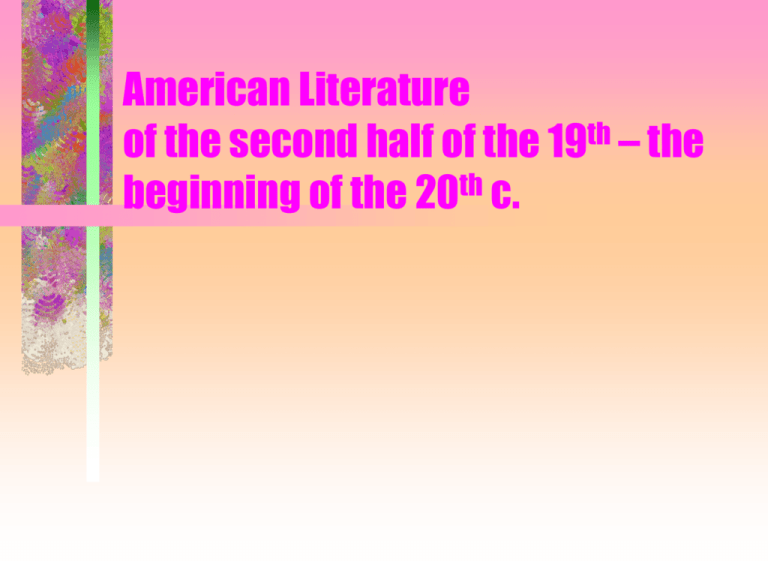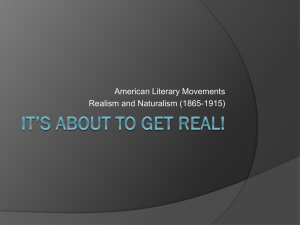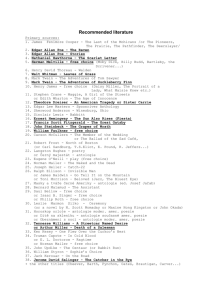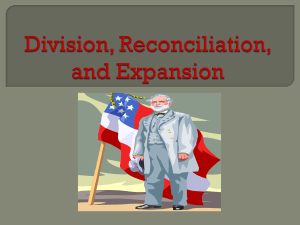American Literature of the second half of the 19th – the beginning of
advertisement

American Literature of the second half of the 19th – the beginning of the 20th c. Realism and the Frontier 1865-1915 • America was changing dramatically in the late 19th century and early 20th century -the Civil War was becoming a hazy memory • The American Frontier no longer existed by 1915 - this did not stem western migration • railroads bridged the continent • the Wright Brothers took their first aircraft aloft at Kitty Hawk, NC in 1903 History Overview • Science and industry were making great leaps forward as was literature after relative quiety of post-war years -- “an impressive array of writers began to appear” • Prewar Romantic writers were still widely read but most new writers were not Romantics. The new writers wanted to portray “life as it was lived, not sentimentally or in flights of fancy.” Goal was REALISM or Naturalism or Regionalism. History Overview • Between 1865-1915 U.S. population grew by more than 42 million people (due to new immigration) • before 1880 most immigrants came from Western Europe and the Scandinavian countries • in the 1880s immigrants came from Southern and Eastern Europe (Italy, Greece, Poland, Russia) History Overview (cont’d.) • Population in older cities, Boston/Baltimore, tripled and quadrupled • Chicago and Detroit also skyrocketed • Major, new cities sprung up (Denver - in 1858 60 crude log cabins, due to Pikes Peak Gold Rush, 3 years later, Denver’s population was 3,000 people) By 1890 the population of Denver exceeded 100,000 A Nation of the Move • Advances in transportation • Mark Twain traveled - “this kind of movement helped to shape both the subject matter and the attitudes of writers in this period” Roughing It • writers now writing about and representing the mid-west and far west – Bret Harte (moved from NYC to CA) – Willa Cather (moved from VA to Nebraska) A Wagner Matinee – Jack London (native CA) To Build A Fire (1897 prospected for gold in Alaska, his early novels were set in Alaska, not in CA) Frontier Experience • 1827 President John Quincy Adams • frontier dwellers were generally mobile, practical, inventive, deomocratic and optimistic • Mark Twain’s writing showed all 5 traits • BUT, the Frontier was not an “idyllic existence” could be lonely and cruel Problems • Along with rapid industrialization came problems – – – – urban slums farming problems labor unrest The Gilded Age by Mark Twain and Charles Dudley Warner “dealt with unrestrained greed in a time of financial speculation and uncertain moral values” National Diversity • Depression in 1893 • farmers faced failing agricultural prices, high interest rates on bank loans, unequal railroad shipping charges • after centuries of conflict, Native American Tribes had been defeated • Restrictive immigration laws prohibited Chinese workers from entering the U.S. after 1882 • European immigrants often worked long hours in sweatshops and lived in slums • Women were not allowed to vote in national elections National Diversity (cont’d.) • Literature reflected this diversity as well as the promise and problems of the frontier and industry Realism in American Literature • “the buoyant spirits of Emerson and the wild imaginings of Poe seemed out of date to many after the war, especially to the young writers” • “Realistic” writers saw themselves as being in revolt against Romanticism Realism (cont’d.) • European Realistic writers: Balzac, Stendhal, Flaubert • Not only did European influences help, American writers had plenty of material on their own, plus the objectivity of science played a part – 1885 The Rise of Silas Lepham by William Dean Howells -- in 1891 he described his theory of Realism in Criticism and Fiction – other Realists: Stephen Crane, Hamlin Garland Naturalism • One step beyond Realism, influenced by French writer Emile Zola - “a writer must examine people and society objectively and, like a scientist, draw conclusions from what is observed • viewed reality as the inescapable working out of natural forces “One destiny is decided by heredity and environment, physical drives and economic circumstances (tended to be pessimistic writers) Naturalism (cont’d.) • 1893 Stephen Crane Maggie: A Girl of the Streets • Jack London To Build A Fire (man at the mercy of the brutal forces of nature) • Frank Norris The Octopus (struggles between wheat growers and an allpowerful railroad in San Joaquin Valley, CA) Regionalism • Also known as the “Local Color Movement” • “through use of regional dialects and vivid descriptions of landscape, Regionalists captured the essence of life in different regions” – Mark Twain “The Notorious Jumping Frog of Calaveras County” – Bret Harte (considered founder of the local color movement) “The Outcasts of Poker Flat” – George Washington Cable (wrote about Creole life in Louisiana Regionalism (cont’d.) • This movement could have come about because people wanted to learn more about others (also due to the advances in transportation) – Edward Eggleston, The Hoosier Schoolmaster (backwoods Indiana) – Sarah Orne Jewett - The County of the Pointed Firs – Mary Wilkins Freeman (rural New England) – Kate Chopin (Louisiana) Creole and Cajun life Poets of the Time • Stephen Crane - short, spare, untitled fables/riddles • Sidney Lanier - fused musical and poetic principles • Paul Laurence Dunbar - used black dialect and folklore • Edwin Arlington Robinson - The Children of the Night, 1897 (contains “unforgettable psychological portraits of people) • Edgar Lee Masters - Spoon River Anthology Poets of the Time (cont’d.) • James Whitcomb Riley - Rustic Hoosier dialect “Little Orphant Annie,” Knee Deep in June” • Eugene Field, Denver journalist, “Little Boy Blue,” “Whynken, Blynken and Nod” • Edwin Markam - “The Man With The Hoe” (Oregon) • Joaquin Miller “Columbus” (Oregon) Famous Short Story Writers • William Sydney Porter (O Henry) - portrayed N.Y. City, uses surprise endings, worked within a customary plot structure with certain familiar character types, settings and situations • Dime Store Novels (Westerns) – Owen Wister - The Virginian, 1902 VOCABULARY • Humor = writing that is intended to evoke laughter • Narration = writing that tells a story (fictional = often inspired by real life events OR factual = some details are fictionalized or exaggerated) • Regionalism = habits, speech, appearance, customs and beliefs of people from one geographical region often differ from those of people from other areas VOCABULARY • Point of View = refers to the vantage point or perspective from which a narrative is told • Imagery = words or phrases that create mental pictures or images, that appeal to one or more of the five senses • Irony = contrast between what is stated and what is meant or between what is expected to happen and what actually happens • Characterization = the means by which a writer reveals a character’s personality VOCABULARY • Conflict = a struggle between two opposing forces or characters, plays a vital role in the plot development • Realism = literary movement that emerged as a reaction against Romanticism • Naturalism = major literary movement of the late 19th century and early 20th century, grew out of Realism • Sound Devices = gives writing a musical quality - 4 most frequently used: alliteration, consonance, assonance, internal rhyme VOCABULARY • Tone = writer’s attitude toward his or her subject, characters or audience • Sonnet = a 14-line lyric poem, usually written in rhymed iambic pentameter (verse with 5 feet per line, each foot consisting of an unstressed syllable followed by a stressed syllable). A sonnet usually expresses a single complete idea or theme • Speaker = voice of the poem









